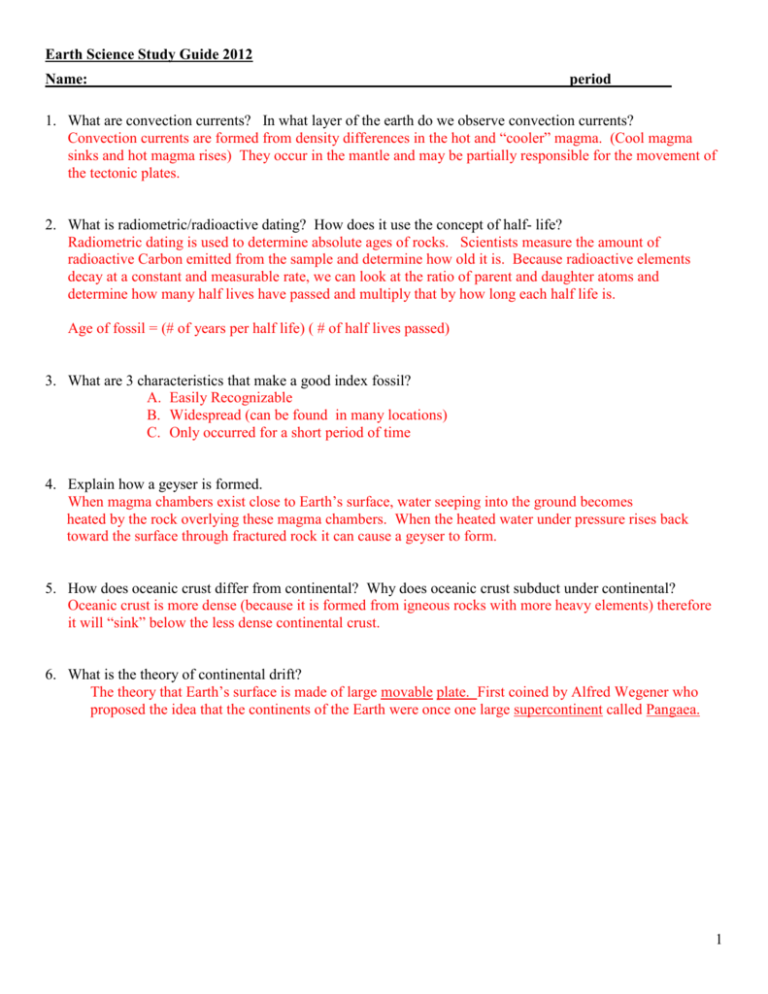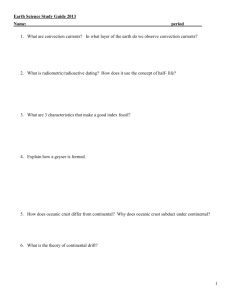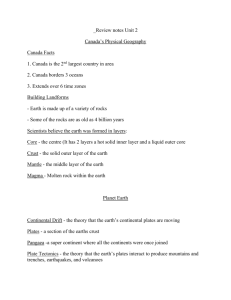Hertzsprung-Russell Diagram
advertisement

Earth Science Study Guide 2012 Name:_______________________________________________________________ period________ \ 1. What are convection currents? In what layer of the earth do we observe convection currents? Convection currents are formed from density differences in the hot and “cooler” magma. (Cool magma sinks and hot magma rises) They occur in the mantle and may be partially responsible for the movement of the tectonic plates. 2. What is radiometric/radioactive dating? How does it use the concept of half- life? Radiometric dating is used to determine absolute ages of rocks. Scientists measure the amount of radioactive Carbon emitted from the sample and determine how old it is. Because radioactive elements decay at a constant and measurable rate, we can look at the ratio of parent and daughter atoms and determine how many half lives have passed and multiply that by how long each half life is. Age of fossil = (# of years per half life) ( # of half lives passed) 3. What are 3 characteristics that make a good index fossil? A. Easily Recognizable B. Widespread (can be found in many locations) C. Only occurred for a short period of time 4. Explain how a geyser is formed. When magma chambers exist close to Earth’s surface, water seeping into the ground becomes heated by the rock overlying these magma chambers. When the heated water under pressure rises back toward the surface through fractured rock it can cause a geyser to form. 5. How does oceanic crust differ from continental? Why does oceanic crust subduct under continental? Oceanic crust is more dense (because it is formed from igneous rocks with more heavy elements) therefore it will “sink” below the less dense continental crust. 6. What is the theory of continental drift? The theory that Earth’s surface is made of large movable plate. First coined by Alfred Wegener who proposed the idea that the continents of the Earth were once one large supercontinent called Pangaea. 1 7. What evidence do we have to support the theory of Continental Drift? Early evidence for Continental Drift 1. Mesosaurus fossil: fossil found in Brazil and western Africa a. Not likely to have swam between continents 2. Shape of continents seemed to fit together like a puzzle 3. Glacial deposits in United States are also found in Greenland and Western Europe 4. Similar rock structures are found on different continents 5. Migration patterns of animals have not changed since it was supercontinent Recent evidence for Continental Drift 1. Magnetic polarity bands near mid-ocean ridge [Fig 6, p.703] a. Alternating magnetic bands, normal versus reversed, on new ocean floor 2. Age of rocks relative to the mid-ocean ridge: the farther away from the mid-ocean ridge, the older the rock 8. What is the Pacific Ring of Fire? An area where a large number of earthquakes and volcanic eruptions occur in the basin of the Pacific Ocean. In a 40,000 km (25,000 mi) horseshoe shape, it is associated with a nearly continuous series of oceanic trenches, volcanic arcs, and volcanic belts and/or plate movements. The Ring of Fire has 452 volcanoes and is home to over 75% of the world's active and dormant volcanoes. About 90% of the world's earthquakes and 81% of the world's largest earthquakes occur along the Ring of Fire. The Ring of Fire is a direct result of plate tectonics and the movement and collisions of lithospheric plates. Explain the following laws: 9. Law of Superposition- In a sequence of undeformed sedimentary rock layers, the rocks get older from top to bottom 10. Principle of Inclusion-A rock unit that contains inclusions of preexisting rocks must be younger than the rock included in it. (the chocolate chips must be older than the cookie) 11. Law of Cross-Cutting Relationships- An igneous rock or fault that cuts across another rock unit must be younger than the unit it cuts across. Matching: layers of the earth A. Crust B. Mantle C. Inner Core D. Outer Core E. Lithosphere 12. Solid and rigid on the outer edge, but gets softer and plastic-like on the inside B 13. Made entirely of liquid metal D 14. Thin layer of crust and upper mantle that makes up the tectonic plates E 15. Hottest layer of the earth C 16. Convection currents here may contribute to the movement of the tectonic plates B 17. This layer is the least dense and therefore floats on the others. A or E 2 Youngest __A__ __E__ __B__ __C__ __D__ __F__ __G__ __H__ Oldest Rock bodies in this cross-section are labeled A through H. One of these rock bodies is an intrusion. Intrusions occur when molten rock called magma penetrates into layers from below. The magma is always younger than the layers that it penetrates. Likewise, a fault is always younger than the layers that have faulted. A fault is a crack or break that occurs across rock layers, and the term faulting is used to describe the occurrence of a fault. The broken layers may move so that one side of the fault is higher than the other. Faulted layers may also tilt. 18. List the rock bodies illustrated above in order based on when they formed. (in the box above) 19. Relative to the other rock bodies, when did the fault occur? How do you know? The law of cross-cutting relationships tells us that the layers affected by the fault must be older than the fault itself. So layers F, G and H must have been deposited before the fault could have moved them. 20. Compared with the formation of the rock bodies, when did the stream form? Justify your answer. Realizing that streams are created when water carves a path in existing rock layers (The rocks did not form AROUND a random puddle of water.) The the law of cross-cutting relationships dicatates that layers A and E must have been deposited before the stream could have carved out its path. 3 23. Label the following as Reverse, Normal or Strike Slip faults and then write if it occurs at a Transform, Convergent or Divergent plate boundary. A- Normal Fault, Divergent boundary B- Reverse Fault, Convergent boundary C- Strike Slip Fault, Transform boundary A B C 21. Draw what happens during seafloor spreading. Label where the rocks are the youngest and oldest. (Rocks are oldest toward the edges and youngest near the center where the magma bubbling up will be turned into brand new rocks as it hits the cold ocean water) Youngest rocks oldest rocks oldest rocks . 4









